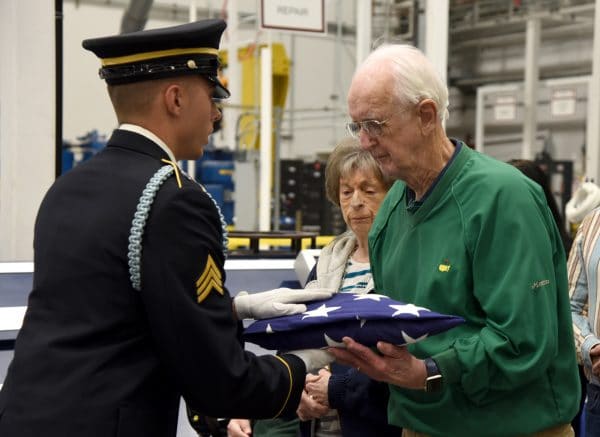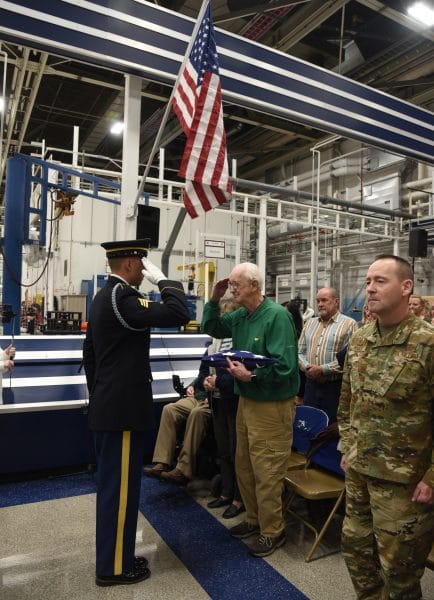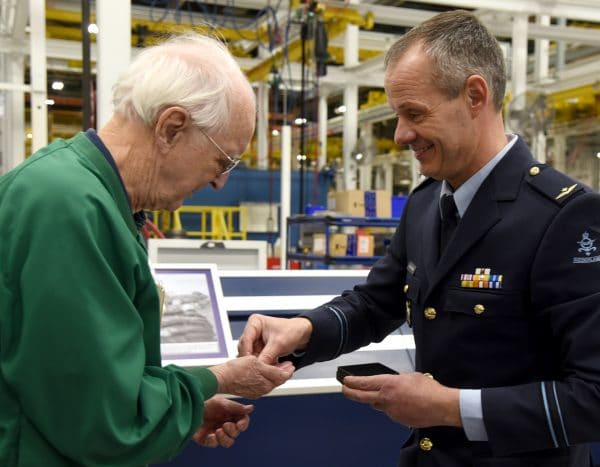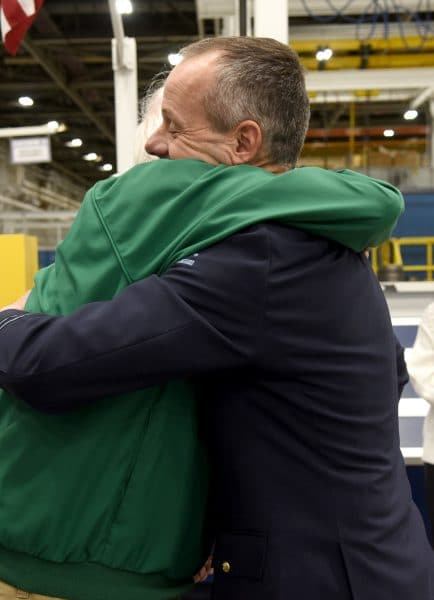Seventy-five years ago, Sgt. Orville Bruce Journey’s plane was shot down by German anti-aircraft fire over the the Netherlands during World War II.
Now, three quarters of a century later, the Columbia-raised airman’s dog tags were brought back home following their recent miraculous discovery.
The dog tags were presented to Bruce Journey’s brother, 87-year-old Oklahoma City resident Dwight Journey, at a special presentation ceremony hosted at Tinker Air Force Base this past November.

Friends, family and members of Team Tinker gathered at Hollywood and Vine in Bldg. 3001 to reunite the dog tags of Tech. Sgt. Orville ‘Bruce’ Journey, who was killed in action during World War II, with his Oklahoma family. Lt. Willem van der Steen, a member of the Royal Netherlands Air Force, found the dog tags on Sept. 21 of this year and brought it to the ceremony to present to Journey’s brother, Dwight. (U.S. Air Force photo/Kelly White)
Inside the very same Oklahoma facility where decades earlier thousands of aircraft were constructed for the war effort, another memory of Sgt. Orville Bruce Journey was returned home to his family.
“For me, this little piece of metal is insignificant in and of itself, but it is symbolic of larger things,” Journey told The Tinker Take Off during the ceremony. “It is symbolic of the sacrifice of my brother’s life on Sept. 23, 1944. Secondly, it is symbolic of the sacrifice of the nearly 400,000 U.S. troops who died during WWII. Third, it is symbolic of the perseverance and dedication of the Dutch people to keep alive the memory of the devastation of the war. It’s the symbolism of what goes on in war.”
The man who found the dog tags, 1st Lt. Willem Van der Steen of the Royal Netherlands Air Force handed off the dog tags during the ceremony.

Friends, family and members of Team Tinker gathered at Hollywood and Vine in Bldg. 3001 to reunite the dog tags of Tech. Sgt. Orville ‘Bruce’ Journey, who was killed in action during World War II, with his Oklahoma family. Lt. Willem van der Steen, a member of the Royal Netherlands Air Force, found the dog tags on Sept. 21 of this year and brought it to the ceremony to present to Journey’s brother, Dwight. (U.S. Air Force photo/Kelly White)
Van der Steen explained that Journey’s plane, a C-47 Skytrain, was shot down Sept. 23, 1944, during Operation Market Garden, a failed military operation to seize key bridges occupied by the Germans in the Netherlands.
Journey, who served as a flight technician, and another airman were killed in the crash while three others survived and were taken prisoner by German soldiers.
“These five soldiers and their plane are just a small part of the United States and its allies’ efforts during World War II to liberate Europe,” Van der Steen said. “But, they are symbolic of the service and sacrifice of the military men and women of that generation.”
Van der Steen personally found the tags while he and a group of fellow volunteers were cleaning the crash site of Journey’s plane.

Friends, family and members of Team Tinker gathered at Hollywood and Vine in Bldg. 3001 to reunite the dog tags of Tech. Sgt. Orville ‘Bruce’ Journey, who was killed in action during World War II, with his Oklahoma family. Lt. Willem van der Steen, a member of the Royal Netherlands Air Force, found the dog tags on Sept. 21 of this year and brought it to the ceremony to present to Journey’s brother, Dwight. (U.S. Air Force photo/Kelly White)
“We were digging with 10 volunteers looking for any kind of evidence of the crash,” Van der Steen said. “I saw a small piece of metal sticking out and I thought it was a piece of a soda can. All of a sudden I pulled it out and I had a dog tag in my hand.”
The discovery of the tag coincides with the 75th anniversary of the American liberation of the Netherlands from German occupation. The anniversary is being observed with a year-long celebration, with commemorations hosted around the country associated with the Allied invasion in September 1944.
“Being a soldier myself, I know how important it is to have a home front that relies on you and supports you while you are deployed,” Van der Steen said. “For the Journey family it is important that they have their last piece of evidence of Bruce in their home, back here in the U.S. That was my job and I think we succeeded.”
The dog tags will join a collection of items Journey keeps in memory of his brother.

Friends, family and members of Team Tinker gathered at Hollywood and Vine in Bldg. 3001 to reunite the dog tags of Tech. Sgt. Orville ‘Bruce’ Journey, who was killed in action during World War II, with his Oklahoma family. Lt. Willem van der Steen, a member of the Royal Netherlands Air Force, found the dog tags on Sept. 21 of this year and brought it to the ceremony to present to Journey’s brother, Dwight. (U.S. Air Force photo/Kelly White)
That collection includes pieces of his brother’s aircraft and a stack of unopened letters sent from his mother to his brother oversees.
“I couldn’t read one of them if I had to,” Journey told reporters from The Oklahoman.
Among the possessions is also a Western Union telegram sent to the family home at 1815 Highland Avenue, informing Ruth Journey of her son’s passing.
“I still remember, I was down the street playing with some kids and my mother called me home,” Journey said. “I was 11 when he died. He was essentially the man of the family. We were children of the Great Depression. Our father died young and left my mother to raise five children.”
Journey described his brother as a resolute young man.
“He was not a great student but a hard working dude,” Journey said. “In Columbia there were not many bad actors. He had a girlfriend who lived at 1801 Highland Avenue. The Aldrson family. They had a dry cleaning business and he worked for her father delivering dry cleaning.”
At that time, Columbia was a community of about 8,000 residents.
“Columbia was really a rural town,” Journey told The Daily Herald. “If a kid got into trouble you had community support. I remember running around in those hills in Columbia. My friend Sonny and I ranged those hills. It was a nice nice town to grow up in. Our roots run deep there. It was just a nice little town with great memories.”
Both Journey and his brother, who was 11 years his senior, graduated from Central High School. Before then, Journey attended the Andrews School on Woodland Street and then went Highland Park Elementary. He played the first basketball game ever played inside the gymnasium at Whitthorne Middle School.
In the years following his brother’s passing, Journey and his eventual bride-to-be, Janice, graduated from the local high school in 1951. The two are now celebrating 66 years of marriage and regularly return to Columbia to visit with friends and attend reunions.
“If there is an emphasis to be made, it is the dedication and appreciation of the Dutch people to remembering our fallen,” Journey said.
For more than two decades the Curfs family have volunteered to take care of his brother’s resting place at the Netherlands American Cemetery and Memorial located in the Dutch village of Margraten. Journey rests with 8,291 other American soldiers.
“They are an amazing family,” Journey said.
The Curfs make sure that Journey’s gravesite is kept in pristine condition. For each Memorial Day and birthday and other major U.S. holidays, members of the family make sure Journey’s gravesite is decorated with flowers.
“It is an honor to adopt a grave,” Benny Curfs told The Oklahoman, during a visit to the United States in 2012. “We want to give something back.”
He was 22 at the time.
The two families first met in 2000 after the Curfs found Journey and his brother, Thomas, visited the cemetery and signed the guest book.
“It was very emotional,” Curfs said. “Everyone cried.”
Journey said he visited his mother’s resting place in 2000 and again two years later.
“It has been a pretty emotional trip,” Journey said. “I am stunned to have stood in the same building that constructed planes like his. It is a mile long and they shut everything down so that by brother could be honored.”
___
© 2020 The Daily Herald
Distributed by Tribune Content Agency, LLC.



